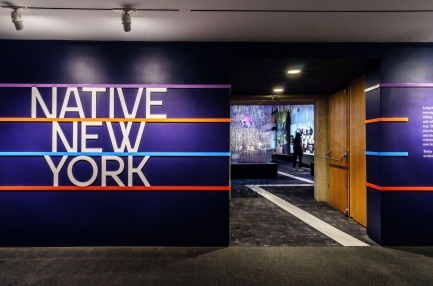What Does It Mean To Be a Native New Yorker?
The Smithsonian’s National Museum of the American Indian, George Gustav Heye Center in New York opens its newest long-term exhibition, “Native New York,” Monday, Oct. 25. Designed for all ages and with content and experiences that meet New York state curriculum standards, the exhibition takes visitors on a journey to 12 significant places in New York, stretching from the shores of Long Island through Manhattan to Niagara Falls. The exhibition uses objects, media, interactives and narrative comics to demonstrate how New York is and always has been a Native place.
“Because Native American histories and cultures are still affected by inaccuracy and stereotyping, it is critical that the museum not only offers more accurate stories of the past, but also shows how those histories impact contemporary life and Native people today,” said David Penney, the museum’s associate director for museum scholarship, exhibitions and public engagement. Penney curated the exhibition with Gabrielle Tayac (Piscataway), whose years of consultations with Native communities (2012–2017) provided the foundation for the exhibition’s scholarship.
Through immersive environments, original illustrations and first-person accounts, “Native New York” shows visitors that the region’s story is far more complex and compelling than outdated myths. Large-scale graphics create a sense of place and a wooden path leads to 12 locations identified with their English and Native place names:
- Battery Park/Kapsee (the sharp rock place)
- Long Island/Poospatuck (where the waters meet)
- Shinnecock Nation/Shinnecock (stony shore)
- Beaver Street/ Tëmakunk (place of beaver)
- Inwood/Shorakapkok (the sitting-down place)
- Van Cortlandt/Keskeskick [translation unknown]
- Empire State Building/ Tiotenonhsáte (the tall house)
- Manhattan/Manahatta (the place for gathering wood to make bows)
- Onondaga Nation Fieldhouse/ Tsha’ Thoñ’nhes (where they play ball)
- Onondaga Lake/ Onoñda’gega’ (people of the hills)
- Aurora/Chonodote (they grow peaches there)
- Niagara Falls/Niagara (thundering water)
Each location serves as a jumping-off point for visitors to encounter a wide range of topics, from an Iroquois Nationals lacrosse game to the intricacies of the 17th-century fur-trade economy. Woven throughout are narratives of resilience, cultural change and continuity; connection to home and community; and the exercising of sovereign rights. The exhibition also features the six-minute film “The Trouble with History.”
In conjunction with the exhibition, the museum’s education initiative, Native Knowledge 360°, released a module on the “sale” of Manhattan in summer 2020. To support the lesson, the museum currently offers virtual field trips led by staff cultural interpreters. The field trips will be available in person once circumstances allow.
The exhibition was designed by C&G Partners, and the media elements were produced by C&G Partners, Fablevision and Baker + Hill; the comics were created by AlterNative Media.
Major support for “Native New York” is provided by the Deutsche Bank Americas Foundation. Support is provided by The Nathan Cummings Foundation, the National Council of the National Museum of the American Indian, the Hudson River Foundation and by public funds from the New York City Department of Cultural Affairs in partnership with the New York City Council.
About the Museum
In partnership with Native peoples and their allies, the National Museum of the American Indian fosters a richer shared human experience through a more informed understanding of Native peoples. For information about the museum, visit americanindian.si.edu. Follow the museum on social media at Facebook, Twitter and Instagram.
# # #
SI-324-2021
Lisa Austin
212-514-3826
Becky Haberacker
202-633-5183
haberackerb@si.edu
Note to editors: The press open house will take place Tuesday, Oct. 26, from 11 a.m.–4 p.m. To attend, email nmaipressoffice@si.edu.




